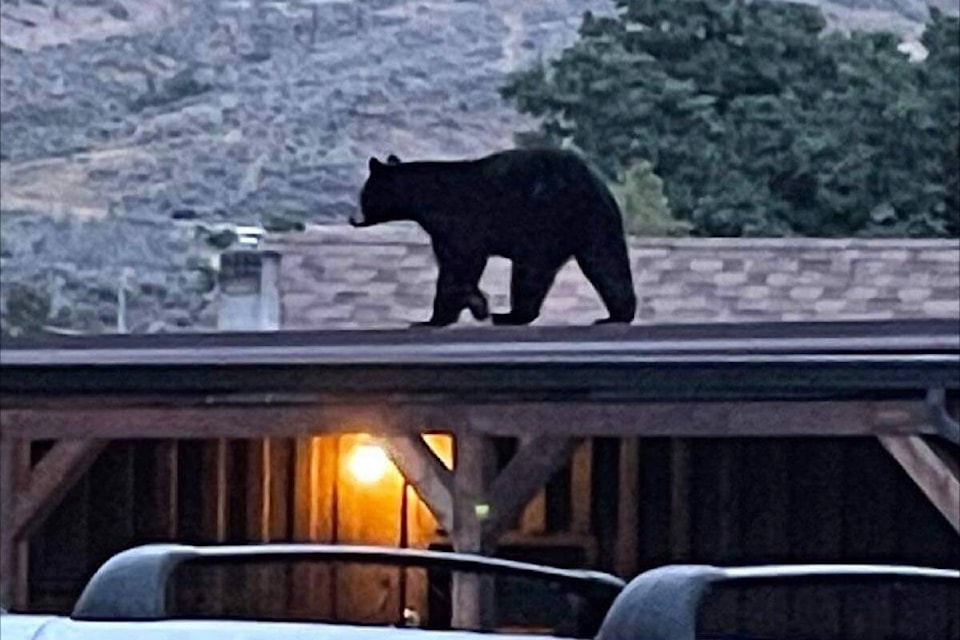The bears are back in town.
It’s the time of year when hungry bruins are fattening up for winter hibernation. They need to consume approximately 20,000 calories a day in preparation, and anecdotal evidence suggests that this year’s wildfires have affected their normal wilderness feeding grounds, causing them to make an earlier than usual appearance in urban environments, where they can often find an all you can eat buffet of fruit, garbage, backyard livestock, pet and chicken feed, compost, and birdseed.
Black bears have been seen in and around Cache Creek and Ashcroft since mid-August. Driven by an insatiable hunger this time of year, the bears — which have a keen sense of smell — are attracted by the rich aromas coming from the many food sources humans unwittingly leave around for them.
While they might look like oversized teddy bears, it’s not always true that they’re more frightened of us than we are of them. The Conservation Officer Service and the RCMP are investigating the death of a woman whose body was found in a field in Pitt Meadows on Aug. 15; it is suspected that the cause of death could have been a bear attack. Bears can also attack dogs and children, and have been known to try to enter homes in pursuit of a hot scent; another reason to keep them out of communities.
Berry-producing plants, nuts, and fish are a natural and important part of a bear’s pre-hibernation diet, but if these are not readily available bears will go in search of food in urban areas. The rich rewards of some of those food sources (one kilo of birdseed contains about 8,000 calories) means that bears can easily become habituated to towns. If they receive a reward for raiding someone’s fruit trees or garbage cans, chances are they will come back again, and habituated bears are much more difficult to relocate successfully: once they have learned a behaviour, they can’t unlearn it.
Vanessa Isnardy, the provincial coordinator for WildSafeBC, says that people should call the Conservation Officer Service (1-877-952-7277) and report when they see a bear in the area. The COS keeps track of the information, which is uploaded onto WildSafeBC’s Wildlife Alert Reporting Program at https://warp.wildsafebc.com/warp/.
The site features an interactive map showing sightings all around the province. By clicking on an icon in your community, you can see details of what animal was spotted, where, and when; you can also sign up for alerts regarding wildlife reports in an area of interest, or create an account and enter your own reports if you spot a bear (or cougar, coyote, skunk, or other wildlife) in your community.
WildSafeBC has some tips for managing the attractants around your house, to discourage bears from dropping by for a snack:
Keep your garbage inside, or secured in a bear-proof enclosure, until the day of collection. Garbage is the number one attractant cited in reports to the provincial hotline.
Manage any fruit trees in your yard. Don’t let windfalls accumulate, and pick the fruit as it ripens. If you don’t want the fruit, consider accessing a fruit gleaning group in your community, or asing friends or neighbours to help you out; washing the blossoms off in the spring so the fruit doesn’t set; or replacing the tree with a non-fruit-bearing variety.
Don’t put out bird feeders when bears are active. There is still plenty of natural food available for birds, which don’t need bird seed or suet until after bears have gone into hibernation.
If you have a backyard composter, keep it working properly with lots of brown materials and a regular schedule of turning.
If you have livestock or backyard chickens, use a properly installed and maintained electric fence to keep bears and livestock (and their feed) apart. This past spring, bears entered a backyard chicken coop in the West Bench area near Penticton, killing the chickens. It’s believed that the smell of the feed drew the bears to the coop.
There is more information about handling attractants at www.wildsafebc.com. The website also has safety tips and videos, including a guide to carrying and using bear spray when walking in bear country. Bear spray has been proven effective against black bears and grizzly bears, as well as cougars.
Remember, if a bear becomes habituated to a food source within a community, it is the animal that will pay the price, so make sure you’re not providing a buffet for hungry bruins.
editorial@accjournal.ca
Like us on Facebook and follow us on Twitter
